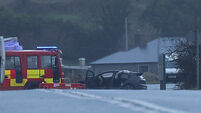New York deals with fallout from Irene
Downgraded to a tropical and then a post-tropical storm, Irene pelted eastern Canada with rain and 50m/h winds after killing 28 people in the US.
It cut power to 5 million homes and businesses and choked towns with floodwaters, especially in Vermont and New Jersey.
New York subways and air travel at major airports slowly started to resume service, but there were delays and overcrowding and commuter rail services, feeding the city from the north and from New Jersey, were out indefinitely. Wall Street was largely unaffected by the storm as was Ground Zero, where the 10th anniversary of the September 11 attacks is soon to be observed.
Suburban New Jersey and rural Vermont were hit particularly hard by flooding. Both states were inundated with rain after an unusually wet summer season left the ground soaked and rivers swelled even before the storm rumbled through.
“It’s very serious for us at the moment in Vermont. The top two-thirds of the state are inundated with rapidly rising waters, which we anticipate will be an issue for the next 24 hours,” said Robert Stirewalt of the Vermont Emergency Management Agency.
The state’s waterways were overflowing, prompting hundreds of evacuations, and some 40,000 to 50,000 people were without power. New Jersey Transit said most rail service would remain suspended until further notice, though some bus service would resume on a limited basis.
In New Jersey, Governor Chris Christie said “we dodged a bullet” after dire predictions failed to produce a catastrophe. But he urged people to stay home from work as the state recovered and pieced together its battered transit system.
“If you don’t have to go to work, don’t go to work,” Christie told a news conference.
Parts of upstate New York were still experiencing severe flooding and Governor Andrew Cuomo urged residents of affected areas to follow the directions of emergency officials.
“I urge residents of the Schoharie Valley and near the Mohawk River to take extreme caution overnight and tomorrow. Follow the directions of local emergency officials. If ordered to evacuate you should do so without hesitation,” he said.
Rivers and streams in New Jersey were expected to peak over the next two days, reaching record or near-record flood levels because the ground was already saturated.
It was not clear how much Irene would cost, but in New Jersey alone the damage was expected to be in “the billions of dollars,” Christie said.
With thousands of homeowners enduring flooding there will be questions over whether insurance policies offer cover and whether the government’s flood programme can handle the claims.
Eqecat, one of the three companies that provide disaster modelling for the insurance industry, said Irene “is a major event and will be responsible for significant levels of insured losses to property and people.”
This year has been one of the most extreme for weather in US history, with $35 billion (€25bn) in losses so far from floods, tornadoes and heat waves.













